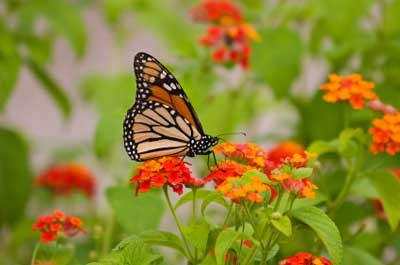Are you happy it is again time to consider purchasing seeds for growing your garden this year? Have you thought about growing something that will lure some interesting critters into your space, so you can enjoy yet another aspect of your garden? Thinking about how to entice other critters into your garden can be challenging, but also very rewarding. Who doesn’t enjoy the beauty and grace of watching butterflies? Who can resist the wonder of a not so attractive worm-like critter transforming itself into a beautiful winged wonder?
Creating a space that is attractive to butterflies is an invitation for these critters to stop for a visit, or even to stay for the season. Ideally, the site should be in a full-sun area that also has some wind protection. It should be located close to outdoor patios and in view of windows you might frequently gaze out of in order to maximize your viewing pleasure.
Spend a bit of time researching butterflies that frequent your climatic area. Learn a bit about their lifecycles and any special characteristics they may prefer. For instance, adding a few rocks will help to create areas that hold the heat and will create spaces for your butterflies to bask.
Plant selection is key to attracting butterflies. One needs to pay attention to both the plants that provide nectar sources as well as plants that are suitable for feeding the larvae. A diverse garden will attract a larger number of different butterfly species.
Of the four life stages of butterflies there are two that require food. The larvae or caterpillar form may have specific food needs like the monarch, which feeds on milkweed. Black swallowtail caterpillars eat the leaves of dill, carrot, parsley and fennel. Other plants that are good for feeding the larvae of butterflies include: hollyhock, mallows, cole crops, sunflowers, lilac, viburnum, birch and oak.
Butterflies need to drink and will get some of their necessary minerals from drinking from puddles in the soil. Adding a patch of damp soil or sand will help keep your winged visitors healthy. It is a good idea to place these wet areas close to a windbreak of trees or shrubs to help give a safe space for these fragile and lightweight creatures. Nectar is an essential food for the adult butterfly as it provides sugar, water and other essential nutrients like amino acids, proteins, enzymes and vitamins. They need a constant source of food in order to entice them to stay in your landscape.
Spring flowering shrubs like lilac or viburnum will provide both shelter and a nectar source in early spring. Be sure to include some summer flowering shrubs for a nectar source in the summer. Later in the season, ripe fruit from viburnum, apples and raspberry are also good to include. Annual and perennial flowers that are attractive to butterflies are a must. Plant selected flowers in mass plantings to give the best attraction from the perspective of the butterfly that are near-sighted and rely heavily on their sense of smell.
Remember, butterflies need to be in a pesticide-free environment as they would be susceptible to any form of insecticide. Resign yourself to putting up with some chewing in order to get the beauty of the butterfly. The immature form of the butterfly is a caterpillar that of course needs to eat. Remember, before the butterfly is the worm!
Hanbidge is the lead horticulturist with Orchid Horticulture. Find us at ; by email at [email protected]; on facebook @orchidhort and on instagram at #orchidhort.
Ìý




